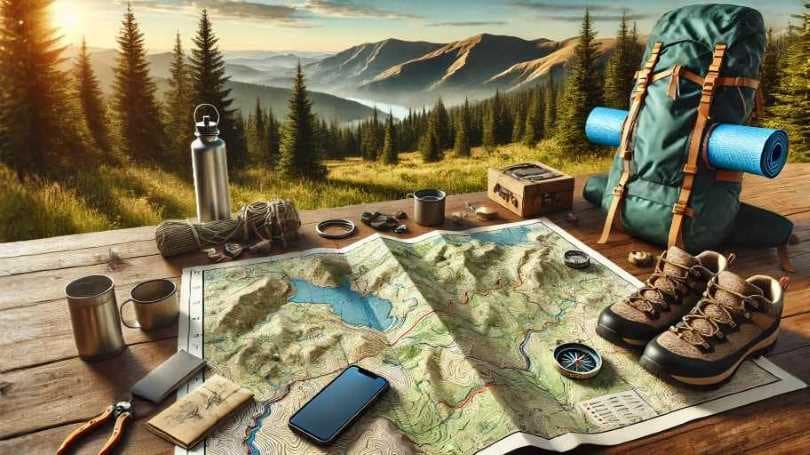Introduction
If you are an outdoor enthusiast, the best offline map app for hiking is a must. Cell service can become spotty or completely unavailable when you are outside of a city. A reliable offline map app means knowing where you are and how to get back no matter what. In this article, we review what the top apps offer: offline hiking maps, unique features, and what truly sets them apart.
Why Offline Maps Matter to Safety While Hiking
Hiking is an excellent means of reconnecting with nature, but in equal measure, it requires a lot of preparation and safety measures. Offline map apps give you the ability to download maps and use them without access to the internet. This feature becomes critical for hikers exploring areas with limited or no cell service, such as Jasper National Park. A good offline mapping app should give detailed trail maps, topographical data, and waypoints that help you navigate efficiently and safely.
Read More: What Are 7 the Best Meditation Apps for Stress Relief?
Features to Look For in the Best Offline Map App for Hiking
The following are some features to look at when searching for the best offline map app for hiking:
- Offline Map Availability: The application must offer high-quality offline maps, which are easy both to download and use.
- Detailed Topography: The provided topographical information needs to include elevation, type of terrain, and water sources.
- GPS Functionality: The app should be using real-time GPS on your phone without the touch of a data connection.
- Route planning and personalization: Choose those apps that will enable you to plan routes, mark waypoints, and customize maps.
- Compatibility with other devices: Some apps offer compatibility with smartwatches and GPS devices, which can be useful for tracking your hikes.
Best Offline Map App for Hiking in 2024: Top Recommendations
While choosing the best offline map application for hiking, a comparison based on features, user experience, and what each has uniquely to offer is quite crucial. The following section goes deeper into the best apps in 2024 and what makes them special:
1. Gaia GPS
Generally, the best choice for advanced hikers and backpackers is Gaia GPS. Its biggest attribute is that this service boasts an unprecedented number and level of detail regarding its map layers. USGS topographic maps, National Geographic Trails Illustrated maps, and satellite imagery are among the options at their disposal. That gives access to vital navigation information such as trail difficulty, terrain, elevation, water sources, and more.
Advanced route planning enables you to chart your hike down to the specifics, create waypoints, and measure distances. The tracking feature of Gaia GPS leverages your phone’s GPS to keep you on track where cell service may be spotty. Once maps are downloaded, they are usable at any time, thanks to its offline functionality. That no doubt makes this one of the best options for cities and other areas where connectivity might be spotty, like Jasper National Park.
| Pros | Cons |
|---|---|
| Wide range of detailed maps. | Subscription required for premium maps. |
| Customizable routes and waypoints. | The interface can be overwhelming for beginners. |
2. AllTrails
AllTrails is an excellent offline map app, targeted at hikers who enjoy social interaction and user-generated content. Boasting more than 200,000 trails from all over the world, the database can allow some very extensive hiking maps. This app allows downloading of maps and then using them offline; hence, it is pretty reliable during remote hikes.
The best part of AllTrails, though, is the community-driven content. Users can leave reviews, upload photos, and generally give insight into the conditions, difficulty, and views of the trail. This becomes very helpful to understand what is waiting along a new path or what the current state of those more popular routes is.
| Pros | Cons |
|---|---|
| Extensive trail database with global coverage. | Limited map options compared to Gaia GPS. |
| Strong community features with user reviews and photos. | Some features locked behind a subscription. |
3. Komoot
Komoot is ideal for those hikers who like a little flexibility in their route planning. This app lets one create customized routes around preferred route characteristics, such as distance, terrain, and elevation gain. It uses high-quality offline maps that provide excellent insights into trails, including surface type, difficulty, points of interest, etc.
Another strong point of Komoot is that it works seamlessly with other devices, from smartwatches to bike computers. This, of course, is a huge advantage for multisport athletes who require one tool to serve in multiple disciplines. This app is very user-friendly and instantly likable, whether by a beginner or an advanced user.
| Pros | Cons |
|---|---|
| Highly customizable routes with detailed planning tools. | Maps may not be as detailed as those offered by Gaia GPS. |
| Integrates well with multiple devices. | Some advanced features require a purchase. |
4. Maps.me
Maps.me is one of the most praised free offline hiking map applications, which is specifically fit for those who need only basic navigation without any additional cost. It offers downloadable maps updated by a community of users, hence keeping up-to-date trail information.
While it might not pack in all of the advanced features of other apps, Maps.me does shine in simplicity and accessibility. The app provides offline turn-by-turn navigation, which should suit a simple trail hike and casual outdoor activities. It also shows amenities like campsites, restrooms, and picnic areas, further adding convenience to your hike.
| Pros | Cons |
|---|---|
| Completely free to use. | Limited features for advanced hikers. |
| Simple and straightforward design. | Does not offer the same level of topographical detail as other apps. |
5. Locus Map
The Locus Map app is better suited for serious hikers and adventurers who require more in-depth control with their mapping tools. The app offers offline maps available in a wide range of highly detailed topographic and satellite options. It also allows users to import their maps-a useful facility for those going to less-documented areas.
Locus Map is in a class of its own when it comes to customization, as it allows a lot of different data formats and has highly personalizable options. The app includes route planning, geocaching support, and offline tracking features that make it versatile for all forms of outdoor activities.
| Pros | Cons |
|---|---|
| High level of customization. | Steeper learning curve. |
| Supports a wide variety of map types. | Some features require in-app purchases. |
How to Choose the Right Offline Hiking Map App for You
The best offline map app for hiking would be a matter of your specific needs. Here are some tips that may help you decide on the best one:
- Assess Your Hiking Style: Are you a casual day hiker or a serious backcountry adventurer? Different apps offer various features that cater to different hiking levels.
- Consider Your Budget: While some of them are free of charge, some may want you to subscribe. Consider what you are willing to spend on the app and its features.
- Check Compatibility: Check if it is compatible with all devices related to it, such as smartphones, tablets, or smartwatches.
- Read User Reviews: It can obtain information about how the app works in everyday situations through user reviews containing information on its reliability and ease of use.
You can also read it: The top nine best business texting apps for 2024
Tips for Using Offline Map Apps Efficiently
For this reason, here are some useful tips to put into consideration to maximize your offline hiking map application:
- Download Maps in Advance: Before you get out, download maps of where you will go. This is just in case you may want to access it at places in the area where cell service is not offered.
- Test the App at Home: Familiarise yourself with the app’s features and interface before your hike. This will save time and reduce frustration on the trail.
- Update maps regularly: This will ensure that you get the latest and most updated information about the trails and features.
Why Offline Map App Are Ideal for Hiking
Using the most suitable offline map application for hiking has its advantages, and these are some of them:
- Safety: As earlier indicated, the use of offline maps enables one to navigate those places where cell services do not exist.
- Convenience: You can plot a route, track your progress, and identify points of interest without requiring an internet connection.
- Access: Most offline map apps will be designed as user-friendly to be accessed by hikers of any skill level.
Jasper National Park Adventure with Offline Map Apps
Jasper National Park is a very popular destination for hikers; however, due to its large size and geographical location, cell service is rarely an option. Having a free offline hiking map application for Jasper National Park allows the ability to enjoy the wide trails available without the burden of getting lost.
This app, along with others such as Gaia GPS and AllTrails, offers detailed maps and trail information to help make your travel across this beautiful natural area safe.
Conclusion
There is something to suit every different kind of hiker’s needs, with so many differing offline map applications available. It may be as simple as finding a user-friendly application that works for the novice, or advanced features may be used to suit the regular trekker.
The right application can make all the difference when it comes to hiking. Always make sure you test the app features in advance and download the necessary maps before you set off.


